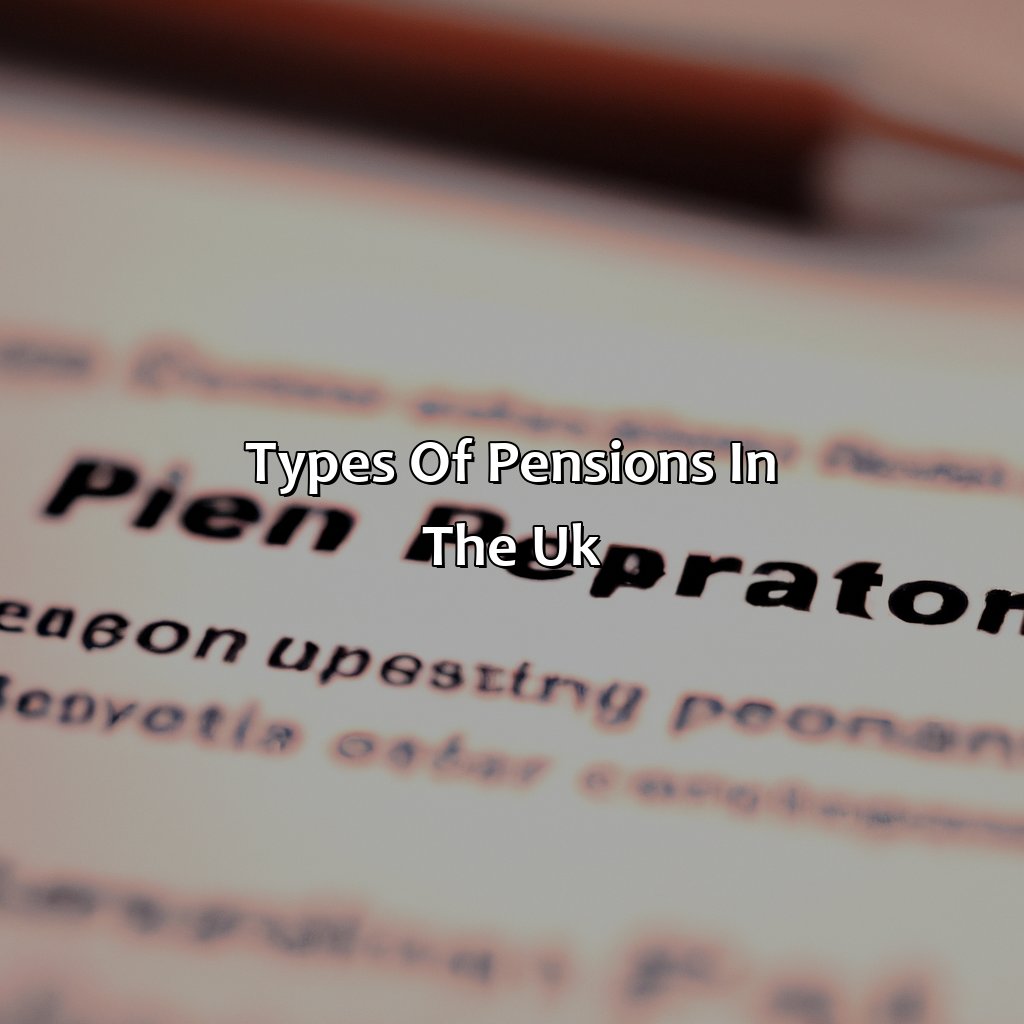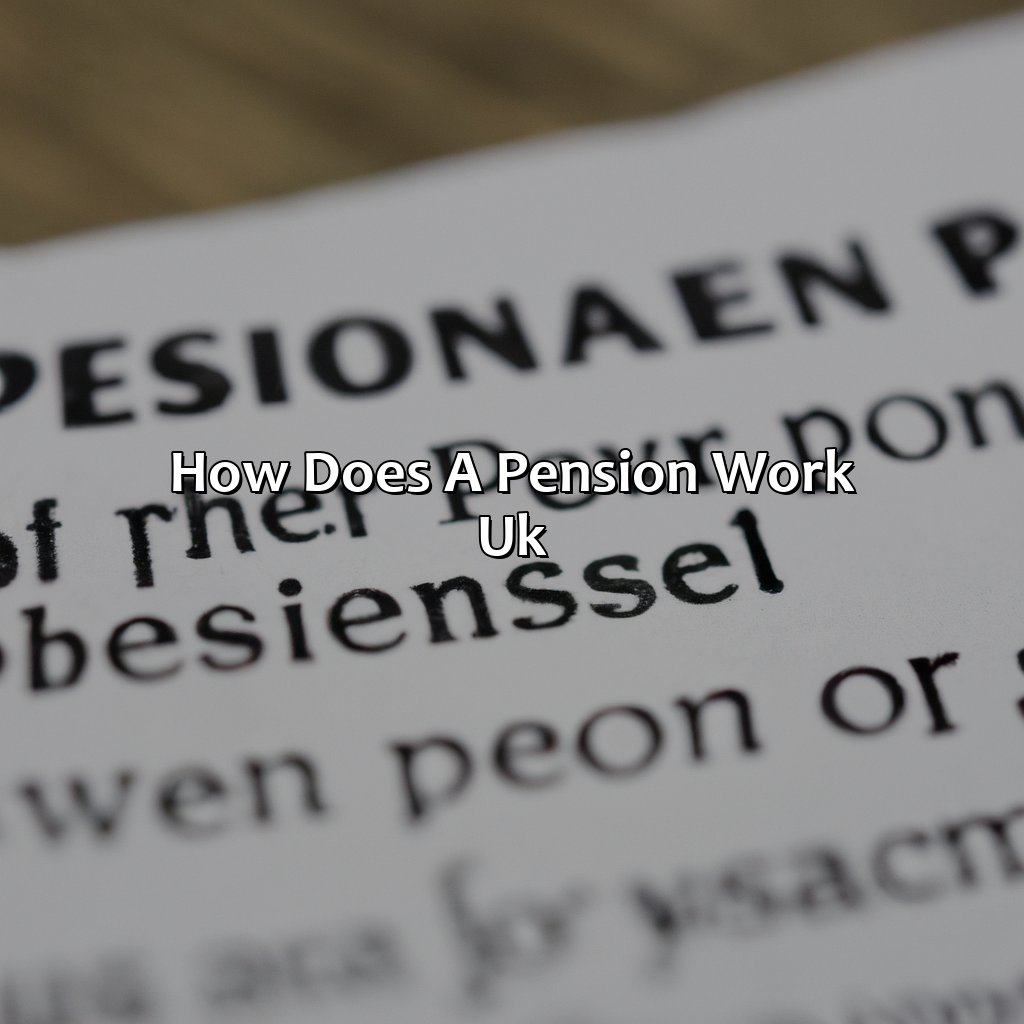How Does A Pension Work Uk?
Key Takeaway:
- There are two main types of pensions in the UK: State Pension and Private Pension.
- Qualifying for State Pension depends on your National Insurance contributions, and the amount you receive is based on your National Insurance record.
- Private Pension options include Workplace Pension, Personal Pension, and Self-Invested Personal Pension. Contributions and retirement benefits vary by type of pension.
Are you confused when it comes to understanding how a pension works? Don’t worry – this article will provide you with all the information you need so you can start planning for your retirement. Begin by understanding the basics of a pension plan and the numerous benefits it offers.
Types of Pensions in the UK
Ascertaining the diversity in the UK pension scheme is crucial to determine the most suitable alternative. This guide covers the various types of pensions available in the UK and their distinctive features without repetition from the upcoming heading.
| Type of Pension | Description |
|---|---|
| State Pension | A retirement pension plan administered by the government based on an individual’s National Insurance history and age. |
| Workplace Pension | An employer-sponsored pension plan structured as a Defined Contribution plan or Defined Benefit plan. Contributions are made by employees and the employer. |
| Personal Pension | A private pension scheme an individual can contribute to independently from their employer or workplace, with a similar structure to a workplace pension. |
| Stakeholder Pension | A type of personal pension with low and flexible contributions. Has capped fund management fees and a default investment strategy. |
| Self-Invested Personal Pension (SIPP) | A private pension scheme that empowers individuals to choose their pension investments. It is available for both commercial and residential property investments and other investments. |
Additionally, individual circumstances should dictate the type of pension scheme opted for. Nevertheless, always consider aspects, such as scheme administration, contribution levels, and other fees.
Pro Tip: Continuously reassess retirement priorities and increase pension contributions when possible.

Image credits: retiregenz.com by Harry Arnold
State Pension
To use the UK State Pension, you must meet the qualifications. You need to know the amount you will get too. We’ll look into qualifying criteria and the amount of money you get in this section.

Image credits: retiregenz.com by Joel Woodhock
Qualifying for State Pension
Earning the right to receive State Pension depends on certain criteria being met. The eligibility for State Pension is determined by a combination of one’s National Insurance contributions, age, and employment status.
Having made enough National Insurance contributions over one’s working life is an integral factor in qualifying for State Pension. The number of contributions required depends on one’s date of birth, with those born after 6 April 1951 needing at least 10 years whereas those born later require at least 35 years. Reaching State Pension Age (SPA) is equally essential as the minimum age varies from individual to individual. Additionally, one must not be working over a certain number of hours a week while receiving state pension.
Retirees can track their State Pension entitlement through personal tax accounts online or per annuam statements from the government. One can start receiving state pension payments four months before they reach SPA provided that they have already applied and been accepted for it.
It is estimated that more than two-thirds of UK citizens don’t know enough about their pension arrangements and may end up leaving themselves short in retirement – says a study by True Potential Investor in partnership with YouGov.
Good news for those of us who can’t math: you don’t have to calculate your State Pension yourself – the government will do it for you. Just don’t expect them to do your taxes too.
How much is State Pension?
The State Pension is pivotal to the retirement income of millions, but how do payments work?
State Pension varies for individuals based on several factors, including National Insurance (NI) contributions made during their working years. The full weekly entitlement in April 2021 is 179.60 with the 35 years of NI record requirement for those who reach state pension age after 6th April 2016. Those approaching retirement before this date are subject to different regulations.
Various personal circumstances affect the estimation of one’s pension income, such as getting credits towards pension qualifying years or applying for National Insurance top-ups at an affordable rate. Still, it should be noted that any private or workplace schemes must also be considered when designing an overall plan.
If you’re wondering about your retirement plan, you might want to know how does PGA pension work in the UK.
One investing in small contributions now receives increased returns on their future benefits and entitlements while not delaying funding their nest egg and avoiding procrastination. Those eligible need to seek professional advice, explore separate ways to accumulate savings, maximize their pensions while working and avoid missing out on any possible benefits or plans that can help secure future incomes.
Private pensions: because being broke in retirement is not a great way to relive your college years.
Private Pension
In the UK, there are three kinds of private pensions: workplace pension, personal pension, and self-invested personal pension. Each type has its own advantages, depending on your objectives and requirements. To help you choose wisely, here’s a brief overview of the different types of private pensions. With this information, you can make an informed decision about your retirement savings.

Image credits: retiregenz.com by Joel Jones
Workplace Pension
A Pension Scheme Funded by Employers – Workplace Pension
Employers in the UK must provide workplace pensions to eligible employees. The pension fund is set up and funded solely by employers to ensure their employees have savings for retirement. Automatic enrollment is mandatory for eligible employees, which includes those over 22 years old and earning at least 10,000 per year. Employees can choose their contribution amount, and employers must also contribute to the ER pension fund.
Additionally, the pension scheme can be enhanced by government tax relief and employer contributions that can increase the amount of money saved towards retirement. By participating in a workplace pension scheme, an employee is guaranteed future financial stability.
Do not miss this excellent opportunity to save up for your golden years! Check with your employer whether you are eligible and enroll now to secure your retirement funds.
Planning for retirement is like playing a game of chess, except the pieces are your savings and the board is the economy.
Personal Pension
Are you wondering about personal pensions? This UK-based investment plan allows you to save money for your retirement without relying on your employer. Contributing regularly guarantees a financially stable future for yourself and your family.
It works by choosing an investment firm to manage your pension contributions. The company invests your saved money in the stock market or other assets, hence growing your savings over time. The amount of income you receive during retirement depends on the size of your fund’s value when you begin withdrawing it. If you’re wondering how to find your pension information, you can check with your employer or pension provider for details.
Personal pensions are flexible and offer several benefits such as tax relief, inheritance protection, and control over when to retire. They are a popular choice among self-employed individuals and those with no access to work-based pensions. Wondering what is EE pension? Learn more about it on RetireGenZ.
In fact, according to HM Revenue & Customs, 12.4 million people in the UK had a personal pension in 2019/2020 fiscal year.
Did you know that there are many different types of pension plans available in the US? Learn more about how many pension plans there are and how they work.
Got trust issues? Invest in a SIPP, the only thing you can count on to have your best interests at heart.
Self-Invested Personal Pension
A Self-Directed Pension scheme enables individuals to invest their pension in a range of assets outside traditional markets, like commercial property and other asset classes. It is governed by UK government rules and regulated by the Financial Conduct Authority. It offers a flexible option for retirement planning with full control over investment decisions.
This type of pension provides access to a range of investments that many other pensions do not allow, and it can be appropriate for those looking to take greater control over their pension savings. A Self-Managed Pension scheme allows investors to invest across different regions, sectors or industries. It gives more choice in the selection of investments and better transparency in costs.
It is important to note that SIPP investments remain subject to fluctuations in value, so investors should seek financial advice before investing. Therefore, investing must be done after thorough research and understanding the potential risks involved.
Sources from Pensions Advisory Service confirm that SIPPs could be complex products suitable for experienced investors with high net worth as there might be an increased risk of significant losses if things go wrong. How to retire in the UK: just keep working until you drop dead, or start contributing to a pension.
How do Pensions Work in the UK?
Know about pensions in the UK? You must understand contributions, tax relief, investing and retirement benefits. Here, we’ll explore them all. We’ll clear away the complexity, furnishing you with simple explanations. Then, you can make wise decisions for your financial future.

Image credits: retiregenz.com by Yuval Washington
Contributions
When it comes to financing your retirement, you may need to consider investing in a pension. It is necessary to understand how your funds will be procured in the coming years before getting too excited about what to do with all that money. Pensions operate by making contributions on a regular basis.
- Employer- As an employee, your employer will contribute a fixed percentage of your wages into the pension scheme.
- You- You can make contributions regularly or by making a one-time payment. Most pension schemes have restrictions on maximum and minimum payments.
- Government- UK government provides tax relief on personal pension contributions, which adds to the overall contribution and helps reduce the burden on individuals.
One important thing to keep in mind is that often employer contributions won’t cover all pension costs. Therefore, regularly reviewing pension provisions and adjusting payments accordingly could bridge any funding gaps instead of being left short-changed when it’s time for retirement.
You could also consider seeking professional advice regarding the best choice for your particular circumstances as there are different types of pensions available such as defined benefit, defined contribution or workplace pensions. These options differ mainly in terms of risk levels, contribution amounts, fixed paybacks or future payouts. If you are specifically looking for a pension that provides for employees, you can check out which of the following IRAs provides a pension for employees in the UK.
Recently a story made headlines where people discovered they were not registered for workplace pensions that their jobs required for more than five years. As a result, these individuals suffered from gaps in their contribution history which put additional burden on them regarding their financial planning at the time of retirement. What is S Pension and how does it work in UK? It is important to understand the pension system to avoid such situations in the future.
Tax relief on pensions is like finding money in your pocket after doing laundry – it’s a nice surprise, but you’re still not exactly rolling in it.
Tax Relief
The UK government provides tax relief to individuals who contribute to their pension fund. This is a way of incentivising people to save for their future retirement. The amount of tax relief received corresponds with the individual’s income tax bracket. For basic taxpayers, the government adds 20% of the contribution to their pension fund, while higher rate taxpayers receive 40%.
In addition, there is an annual allowance limit on how much an individual can contribute into their pension fund and still receive tax relief. The current limit is 40,000 per year or 100% of your salary, whichever is lower. Unused allowance from the past three years can also be carried forward and used in the current year.
It’s important to note that there are other rules surrounding pension contributions and withdrawals that could impact the amount of tax relief received or additional taxes paid.
Pro Tip: It’s important to regularly review your pension contributions and consult with a financial advisor to ensure you’re maximising on available benefits and minimising taxes payable.
Investment advice: if you want to retire rich, invest in stocks. If you want to retire broke, invest in your kid’s college tuition.
Investment
When it comes to safeguarding your financial future, investment planning is crucial. With a sound investment plan, you can ensure that you are financially secure in your retirement years. In the UK, pension schemes offer one of the most popular investment options for this purpose.
Pension schemes generally work by setting aside a portion of an individual’s earnings throughout their working years so that they have a comfortable source of income once they retire. This involves making investments in various financial instruments such as stocks and bonds that provide long-term returns that help increase the amount of money saved over time.
While there are several types of pensions schemes available in the UK, including state-sponsored options such as the National Insurance Pension, private pension plans often offer more flexibility and control over your investment decisions. Additionally, some employers may also provide workplace pension schemes that offer additional benefits such as matching contributions.
One thing to keep in mind when considering an investment plan through pension schemes is to start early. The earlier you begin investing, the more time your savings will have to grow, which can lead to significant returns over the long run. If you are wondering how does a pension fund work, it’s a system where your contributions are invested and then paid out to you as retirement income.
Investment planning through pension schemes has been around for centuries. One of the earliest examples can be traced back to ancient Rome where soldiers were provided with pensions after serving for 20 years or more. Today, with advancements in financial technology and increased awareness among individuals about saving for their futures, pension schemes continue to serve as a reliable and effective means of investment planning for many people in the UK.
Retirement benefits: Where you trade in your office desk for a fishing rod, hoping to catch some money to make up for your dwindling pension.
Retirement Benefits
Retirement benefits are an essential aspect of a working person’s financial plan for when they retire. They help to provide financial support in the form of regular income or lump sum payments to those who have retired from their jobs.
The following are some common types of retirement benefits:
- Private Pension Schemes: These schemes can be defined benefit or defined contribution, and they are often provided by employers to their employees as part of their compensation packages.
- State Pension: This is a UK government-funded pension scheme that provides a basic level of income for those who have reached the state retirement age.
- Workplace Pensions: Employers are now required by law to automatically enroll eligible employees into workplace pensions.
- Pension Freedom: Introduced in 2015, this policy allowed individuals greater flexibility in accessing their pension savings after reaching the age of 55.
Retirement benefits are not only essential for financial security but also offer peace of mind during old age. One significant benefit is that it allows retirees to maintain their standard of living and enjoy life without relying on family or friends for support. Find out more about who manages pension funds.
Inaction in considering your retirement benefits now leads to years of financial struggles and stress later. It is essential to plan ahead and take advantage of all types of retirement schemes available. Don’t miss out on securing your future; start looking into pension schemes today!
Five Facts About How Does A Pension Work UK:
In the UK, workers are automatically enrolled in a workplace pension scheme if they meet certain criteria, such as being over 22 years old and earning at least 10,000 per year. (Source: Money Advice Service)
Employers are required by law to contribute to their employees’ pension schemes, with a minimum contribution rate set by the government. (Source: The Pensions Regulator)
Workers can choose to opt out of their workplace pension scheme, but will miss out on the employer contributions and tax relief. (Source: GOV.UK)
The state pension in the UK is a regular payment from the government that most people can claim when they reach state pension age. (Source: Age UK)
Personal pensions and self-invested personal pensions (SIPPs) are also available in the UK, offering individuals more control over their pension savings and investments. (Source: MoneySuperMarket)
FAQs about How Does A Pension Work Uk?
How does a pension work in the UK?
A pension in the UK is a way to save money for retirement. Individuals contribute a portion of their income into a pension fund, which is then invested to provide income in the future. When the individual reaches retirement age, they can start to withdraw this money as income to support themselves.
What are the different types of pensions in the UK?
The two main types of pension in the UK are defined benefit (DB) schemes and defined contribution (DC) schemes. A DB scheme promises a certain level of retirement income based on factors such as salary and length of service. A DC scheme, on the other hand, accumulates contributions over time and the final pension depends on the amount invested and investment performance.
How do I know if I am eligible for a workplace pension in the UK?
If you are aged between 22 and state pension age, earn more than 10,000 per year, and work in the UK, your employer must offer you a workplace pension scheme by law. If you meet these criteria, your employer will enroll you in the scheme automatically. However, you have the option to opt out if you so choose.
How much should I contribute to my pension in the UK?
The amount that you should contribute to your pension in the UK depends on your individual circumstances. As a rule of thumb, it’s a good idea to aim for a pension pot that will provide you with around two-thirds of your pre-retirement income. Most workplace pensions in the UK require a minimum contribution of 5%, with the employer contributing an additional 3% and the remaining 2% coming from the employee.
What happens to my pension if I change jobs in the UK?
If you have a workplace pension in the UK and you change jobs, you have a few options. You can choose to leave your pension where it is, continue to contribute to it if possible, transfer it to your new employer’s scheme if they have one, or transfer it to a personal pension plan.
Can I access my pension early in the UK?
In general, you can’t access your pension in the UK until you reach the minimum pension age of 55. However, in certain circumstances (such as ill health), you may be able to access your pension earlier. It’s important to remember that if you do access your pension early, it may lead to lower income in retirement.
 Checkout this IRS Loophole
Checkout this IRS Loophole 
